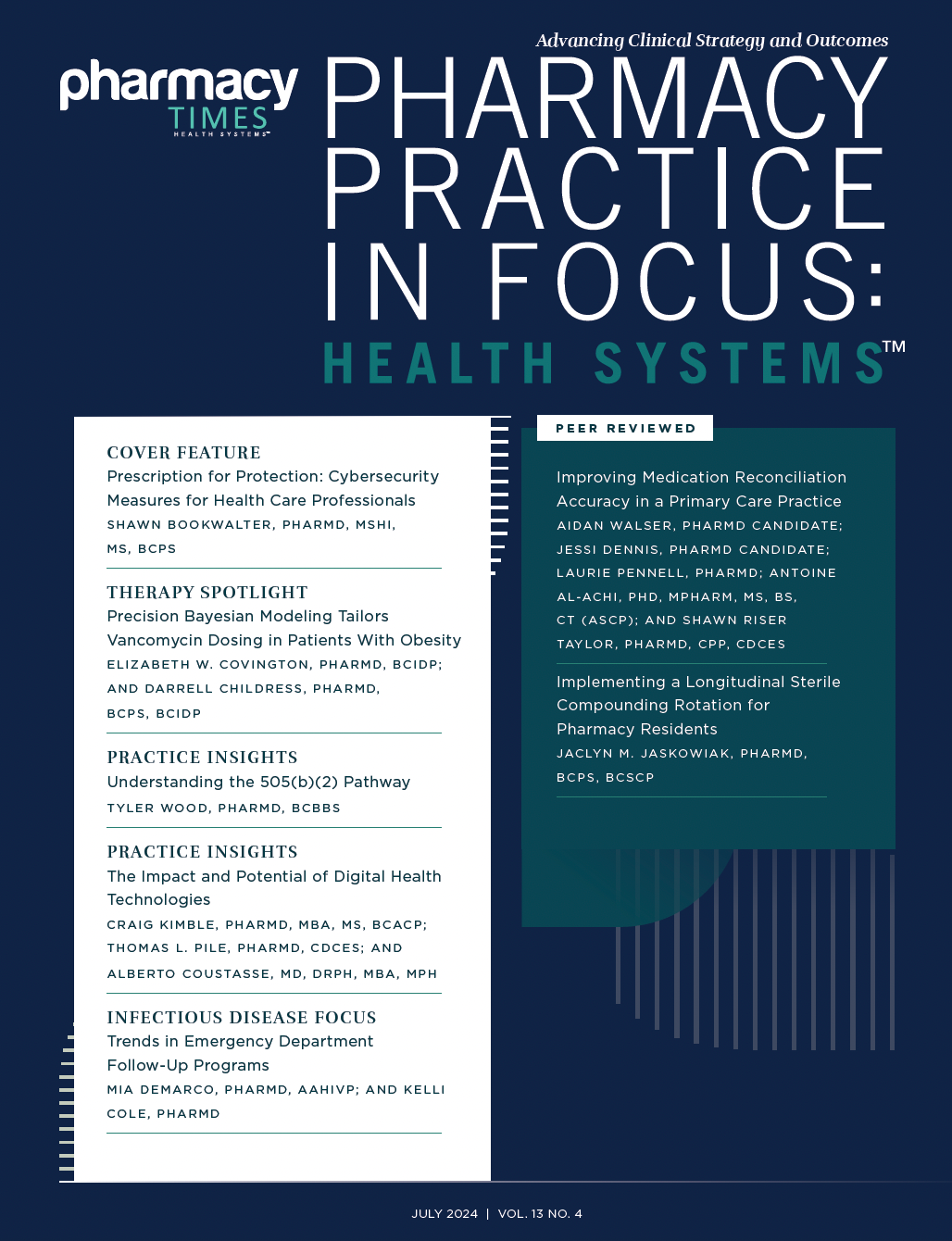The emergency department (ED) is a vital location for providing health care services, assisting nearly 150 million individuals annually in the US.1 It is also an important setting to consider when analyzing trends in antibiotic use with emergency medicine (EM) providers, who are responsible for approximately 12 million outpatient antibiotic prescriptions annually.1,2 Unfortunately, nearly one-third of these prescriptions may be inappropriate or unnecessary, prompting the implementation of antimicrobial stewardship interventions such as ED culture followup.3 The inappropriate use of antimicrobials contributes to antimicrobial resistance, adverse drug events, and Clostridioides difficile infections, making optimization of antimicrobial use a patient safety priority.4
The general workflow of an ED culture follow-up program is prompted by a review of microbiological testing (eg, blood cultures, urine cultures, sexually transmitted infection testing, etc) updates that result after a patient is discharged from an ED. Optimal situations for intervention include, but are not limited to, the following:
- An organism that likely represents a pathogen in patients with signs and symptoms consistent with infection was identified but not treated by the time of ED discharge.
- An organism that likely represents a pathogen in patients with signs and symptoms consistent with infection was identified but empirically treated with an ineffective antimicrobial after ED discharge.
- An organism that warrants further infectious disease workup and a return to the ED was identified.
Once these situations are identified, an alternative treatment plan is created, and the patient is instructed to pick up a new antimicrobial prescription or seek additional medical attention. There may also be opportunities to integrate antimicrobial stewardship audit and feedback processes to educate prescribing clinicians, representing a core practice for improving antimicrobial use supported by the Infectious Diseases Society of America, Society for Healthcare Epidemiology of America, CDC, and Joint Commission.5-8
Historically, many ED culture follow-up programs relied heavily on physicians, advanced practice providers, and nurses. Nurses often play critical roles in these programs as liaisons between microbiology laboratory personnel, prescribing clinicians, and patients.9-11 Additionally, nurse-led postdischarge programs have demonstrated significant reductions in ED revisits.9 With the expansion of emergency pharmacy services and quality improvement initiatives nationwide, models that integrate pharmacists have become increasingly common.10-18 Additionally, the American Society of Health-System Pharmacists advocates for pharmacist integration in ED culture follow-up programs due to downstream decreases in time to positive culture review and notification of a patient or primary care provider, reductions in revisits and readmissions, and improved appropriateness in antimicrobial prescribing.19
Pharmacist roles and responsibilities may differ across ED culture follow-up programs, but multidisciplinary collaboration and independent practice are common strategies. Although some programs place full responsibility on pharmacists via collaborative practice agreements or other institutional protocols to optimize antimicrobial use without compromising clinical outcomes, many rely on multidisciplinary conversations and consultation.10-13 Pharmacist integration is associated with increased guideline-concordant antimicrobial prescribing and decreased antimicrobial prescribing for inappropriate indications, such as asymptomatic bacteriuria.10 One site demonstrated these trends after updating their program so that nurses identified urine cultures for pharmacist review; pharmacists made recommendations to EM providers to optimize antimicrobial selection, dosing, and duration; and EM providers finalized treatment plans.10 Similar benefits in antimicrobial use have been described among community EDs with collaborations between pharmacists and advanced practice providers.14 Pharmacists can also support ED culture follow-up programs by contacting patients and counseling them on their updated results and treatment plans, which can help decrease the workload of EM providers and unplanned ED readmissions.15 Additionally, results from several studies have demonstrated that pharmacist-facilitated culture review correlates with quicker action and a greater intervention volume than nurse-driven protocols.16,17
About the Authors
Mia DeMarco, PharmD, AAHIVP, is a PGY-2 infectious diseases resident at UVA Health in Charlottesville, Virginia. She is passionate about pediatric infectious diseases and hopes to collaborate with multidisciplinary teams to advance antimicrobial stewardship initiatives and positively impact patient care in her postresidency endeavors.
Kelli Cole, PharmD, is a medical science liaison for ViiV Healthcare and chair of the Society of Infectious Diseases Pharmacists (SIDP), providing scientific support for HIV treatment and prevention products through education, engagement, and evidence generation with health care providers in her region. Cole has been involved with SIDP for over 10 years, serving on the stewardship, social media, and publications committees.
In addition to pharmacists, pharmacy residents with antimicrobial stewardship training can be empowered to review and triage updated results, identify opportunities for intervention, collaborate with ED providers to create appropriate treatment recommendations, and communicate updates to patients.18 The investigators of one cohort study found that pharmacy resident integration was associated with decreased time to culture review and fluoroquinolone prescribing compared with reliance on ED administrative support staff without formal clinical training.18 Certified pharmacy technicians may also be trained to support ED culture follow-up programs through expanded roles. Literature describing the integration of pharmacy technicians in ED culture follow-up programs is limited; however, pharmacy technicians have been instrumental in the expansion of other transitions-of-care programs following training focused on patient communication, motivational interviewing, medication history taking, and teach-back skills.20
Although culture follow-up protocols vary, pharmacy personnel are well equipped to contribute to team-based care and optimize antimicrobial use via their integration. Over time, programs may rely more heavily on pharmacy support through various strategies and collaborations.
References
Estimates of emergency department visits in the United States, 2016-2021. National Center for Health Statistics. Updated July 26, 2023. Accessed March 26, 2024. www.cdc.gov/nchs/dhcs/ed-visits/index.htm
Outpatient antibiotic prescriptions – United States, 2022. CDC. Updated November 15, 2023. Accessed June 10, 2024. https://archive.cdc.gov/#/details?q=outpatient%20antibiotic%20prescriptions%20-%20united%20states,%202022&start=0&rows=10&url=https://www.cdc.gov/antibiotic-use/data/report-2022.html
Denny JK, Gartside JG, Alcorn K, Cross JW, Maloney S, Keijzers G. Appropriateness of antibiotic prescribing in the emergency department. J Antimicrob Chemother.2019;74(2):515-520. doi:10.1093/jac/dky447
Core elements of hospital antibiotic stewardship programs. CDC. March 14, 2024. Accessed June 10, 2024. https://www.cdc.gov/antibiotic-use/hcp/core-elements/hospital.html?CDC_AAref_Val=https://www.cdc.gov/antibiotic-use/core-elements/hospital.html
Dumkow LE, Geyer AC, Davidson LE. Antimicrobial stewardship at transitions of care. Infect Dis Clin North Am. 2023;37(4):769-791. doi:10.1016/j.idc.2023.06.007
Dellit TH, Owens RC, McGowan JE Jr, et al; Infectious Diseases Society of America; Society for Healthcare Epidemiology of America. Infectious Diseases Society of America and the Society for Healthcare Epidemiology of America guidelines for developing an institutional program to enhance antimicrobial stewardship. Clin Infect Dis. 2007;44(2):159-177. doi:10.1086/510393
Sanchez GV, Fleming-Dutra KE, Roberts RM, Hicks LA. Core elements of outpatient antibiotic stewardship. MMWR Recomm Rep. 2016;65(6):1-12. doi:10.15585/mmwr.rr6506a1
New and revised antibiotic stewardship requirements: hospital (HAP) accreditation program. The Joint Commission. 2022. Accessed June 10, 2024. https://www.jointcommission.org/-/media/tjc/documents/standards/prepublications/effective-2023/compare_hap_jan2023_prepublication_report_antibiotic_stewardship.pdf
Luciani-McGillivray I, Cushing J, Klug R, Lee H, Cahill JE. Nurse-led call back program to improve patient follow-up with providers after discharge from the emergency department. J Patient Exp. 2020;7(6):1349-1356. doi:10.1177/2374373520947925
Zhao Y, Stornelli N, McAllister K, McDaniel L, Schad J. Evaluating the impact of emergency department clinical pharmacist integration within a discharge urine culture follow-up program. J Am Coll Clin Pharm. 2023;6(9):1008-1014. doi:10.1002/jac5.1853
Olson A, Feih J, Feldman R, Dang C, Stanton M. Involvement of pharmacist-reviewed urine cultures and sexually transmitted infections in the emergency department reduces time to antimicrobial optimization. Am J Health Syst Pharm. 2020;77(suppl 2):S54-S58. doi:10.1093/ajhp/zxaa064
Pham D, Lee S, Abrishami S, Chakravarthy B, Saadat S. Utilization and impact of pharmacist-led, urinary culture follow-up after discharge from the emergency department. West J Emerg Med. 2023;24(3):396-400. doi:10.5811/westjem.59116
Cornell WK, Hile G, Stone T, Hannum J, Reichert M, Hollinger MK. Impact of advanced practice pharmacists on a culture response program in the emergency department. Am J Health Syst Pharm. 2022;79(suppl 4):S106-S114. doi:10.1093/ajhp/zxac157
Rainess RA, Patel VV, Cavanaugh JB, Hill J. Evaluating the addition of a clinical pharmacist service to a midlevel provider-driven culture follow-up program in a community emergency department. J Pharm Technol. 2021;37(3):140-146. doi:10.1177/87551225211000363
Randolph TC, Parker A, Meyer L, Zeina R. Effect of a pharmacist-managed culture review process on antimicrobial therapy in an emergency department. Am J Health Syst Pharm. 2011;68(10):916-919. doi:10.2146/ajhp090552
Santiago RD, Bazan JA, Brown NV, Adkins EJ, Shirk MB. Evaluation of pharmacist impact on culture review process for patients discharged from the emergency department. Hosp Pharm. 2016;51(9):738-743. doi:10.1310/hpj5109-738
Davis LC, Covey RB, Weston JS, Hu BB, Laine GA. Pharmacist-driven antimicrobial optimization in the emergency department. Am J Health Syst Pharm. 2016;73(5 suppl 1):S49-S56. doi:10.2146/sp150036
Shealy SC, Alexander C, Hardison TG, et al. Pharmacist-driven culture and sexually transmitted infection testing follow-up program in the emergency department. Pharmacy (Basel). 2020;8(2):72. doi:10.3390/pharmacy8020072
Ortman MJ, Giesler Johnson E, Jarrell DH, et al. ASHP guidelines on emergency medicine pharmacist services. Am J Health Syst Pharm. 2021;78(3):261-275. doi:10.1093/ajhp/zxaa378
Bailey JE, Surbhi S, Bell PC, Jones AM, Rashed S, Ugwueke MO. SafeMed: using pharmacy technicians in a novel role as community health workers to improve transitions of care. J Am Pharm Assoc (2003). 2016;56(1):73-81. doi:10.1016/j.japh.2015.11.011








